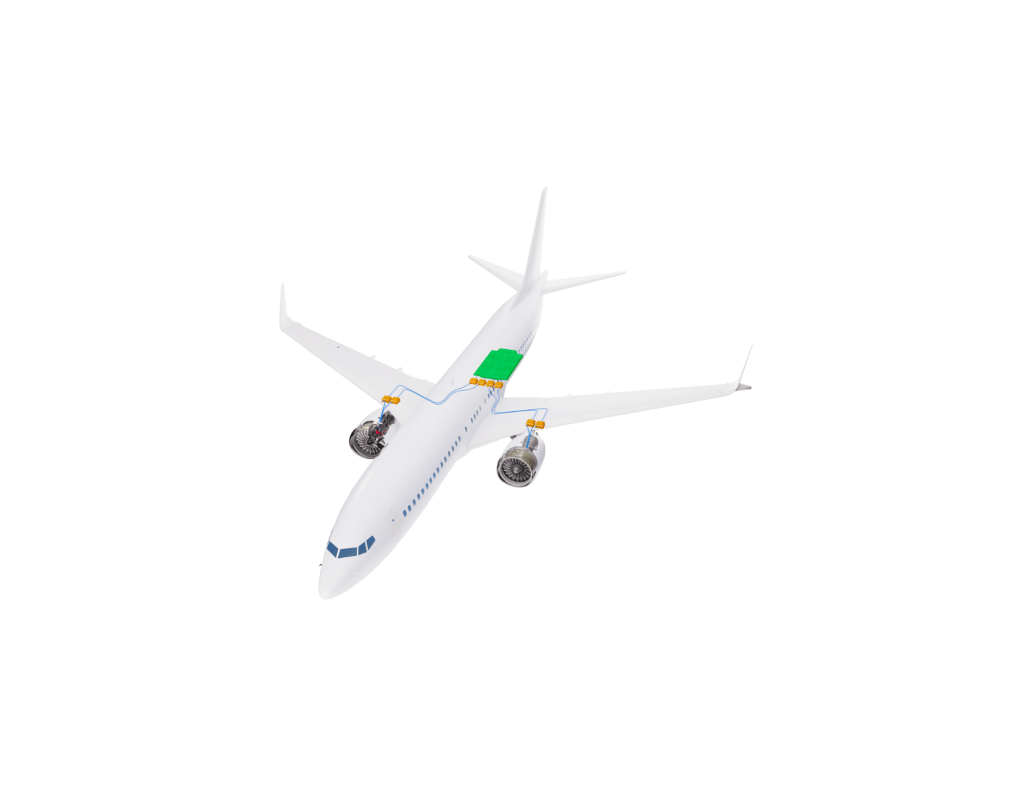The Shuttle-Mir Program, the first cooperative human space flight endeavor between the United States and Russia since the Apollo-Soyuz Test Project of the mid-1970s, grew out of bilateral government agreements signed in 1992. The collaboration provided much needed experience for both sides in working together, particularly important once Russia was brought aboard as a partner in the International Space Station (ISS) Program in 1993. As the Shuttle-Mir Program was initially envisioned, a Russian cosmonaut would make a short-duration flight aboard the U.S. Space Shuttle, an American astronaut would complete a long-duration flight aboard the Russian space station Mir, and a Space Shuttle would dock with Mir to return the astronaut to Earth. Central to this effort was the conduct of life sciences experiments while the astronaut was aboard Mir, providing NASA with its first long-duration experience since Skylab in the early 1970s. To support the investigations, NASA deployed research hardware to Mir, the first items launched aboard Progress resupply vehicles and the majority installed aboard Spektr, a science module that had been awaiting launch to expand the station’s capabilities. When the Shuttle-Mir Program later expanded to include additional astronaut flights to Mir, NASA also outfitted the Priroda module with research hardware. To denote its strong link as a pathfinder for ISS, it became known as the ISS Phase 1 Program.
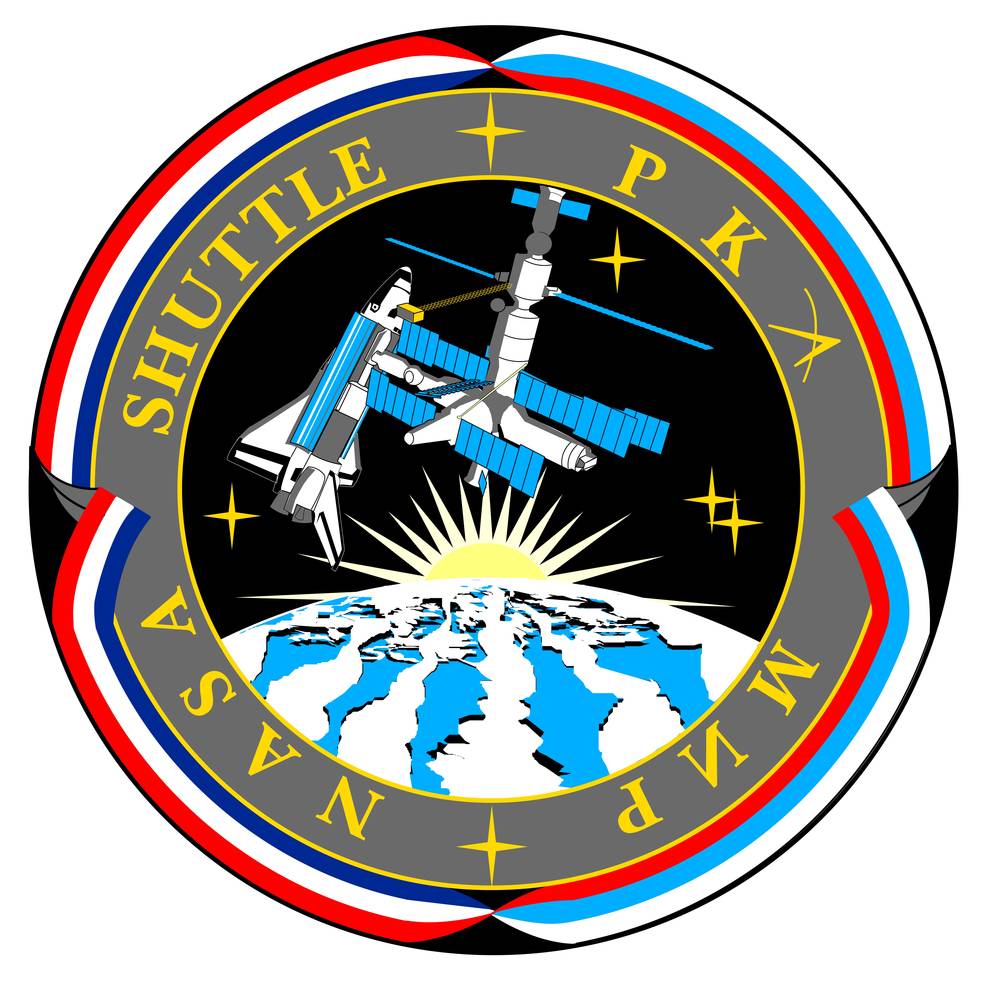
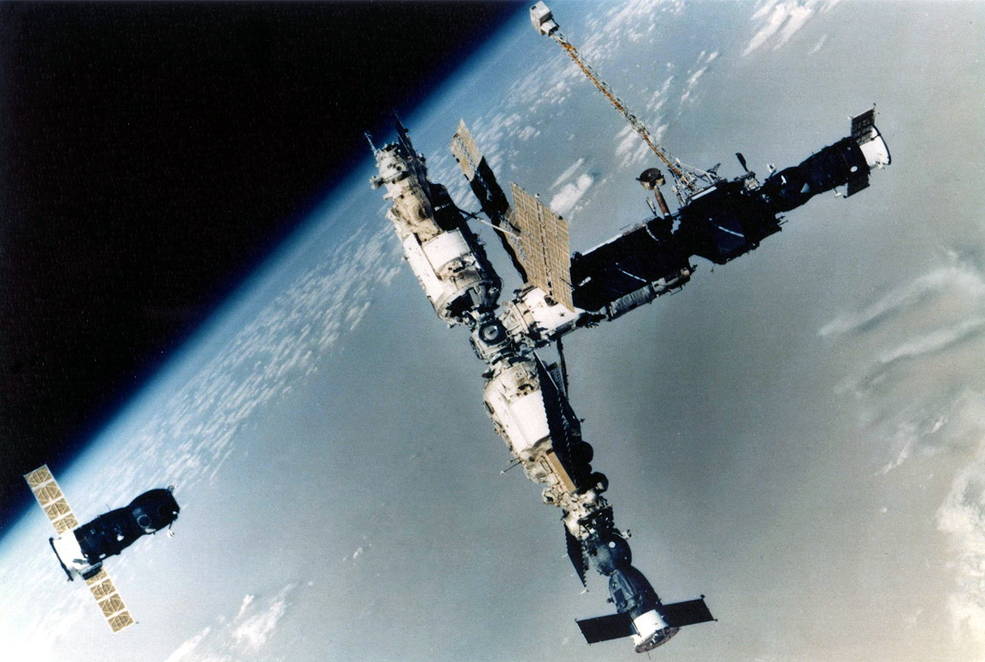
Left: Official patch of the Shuttle Mir Program. Right: Mir space station as
it appeared in 1994 photographed by cosmonauts aboard a station-keeping Soyuz
spacecraft – Base Block, Kvant 1 and a docked Progress cargo vehicle are at upper right,
Kvant 2 is the module facing upward, Kristall with a docked Soyuz facing downward,
and a Progress approaches from the lower left.
The first element of the Shuttle-Mir agreement, flying a Russian cosmonaut aboard a Space Shuttle, occurred in February 1994. Russia assigned two veteran cosmonauts to STS-60, Sergei K. Krikalev as prime and Vladimir G. Titov as his backup. Space Shuttle Discovery lifted off on Feb. 3 on an eight-day mission, during which Krikalev conducted several joint American-Russian biomedical experiments together with his five crewmates. American and Russian managers added a second Shuttle mission with a Russian onboard, and this time Titov and Krikalev traded places. The STS-63 flight launched on Feb. 3, 1995, with Titov conducting experiments with his five American crewmates. As an additional task of the mission, Space Shuttle Discovery conducted a rendezvous with Mir, approaching to within 30 feet of the Russian space station, as a rehearsal for the Shuttle-Mir docking planned for later in 1995. During this so-called “Near Mir” mission, the crews aboard Discovery and Mir communicated via radio and could see each other through their respective windows.
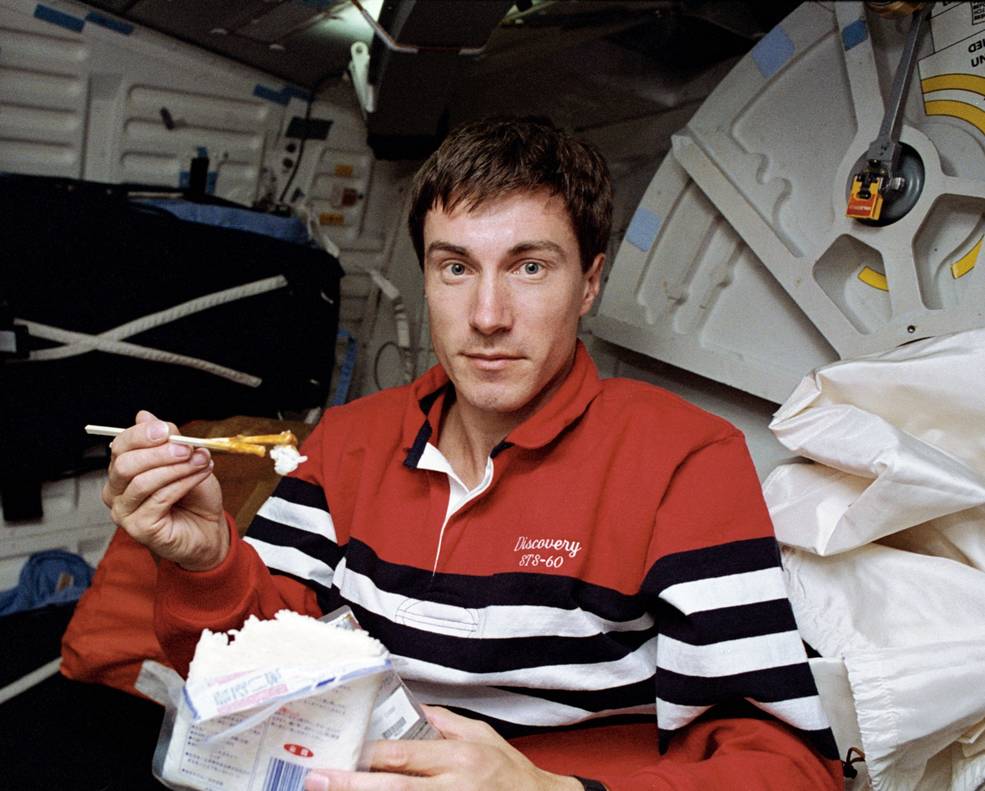
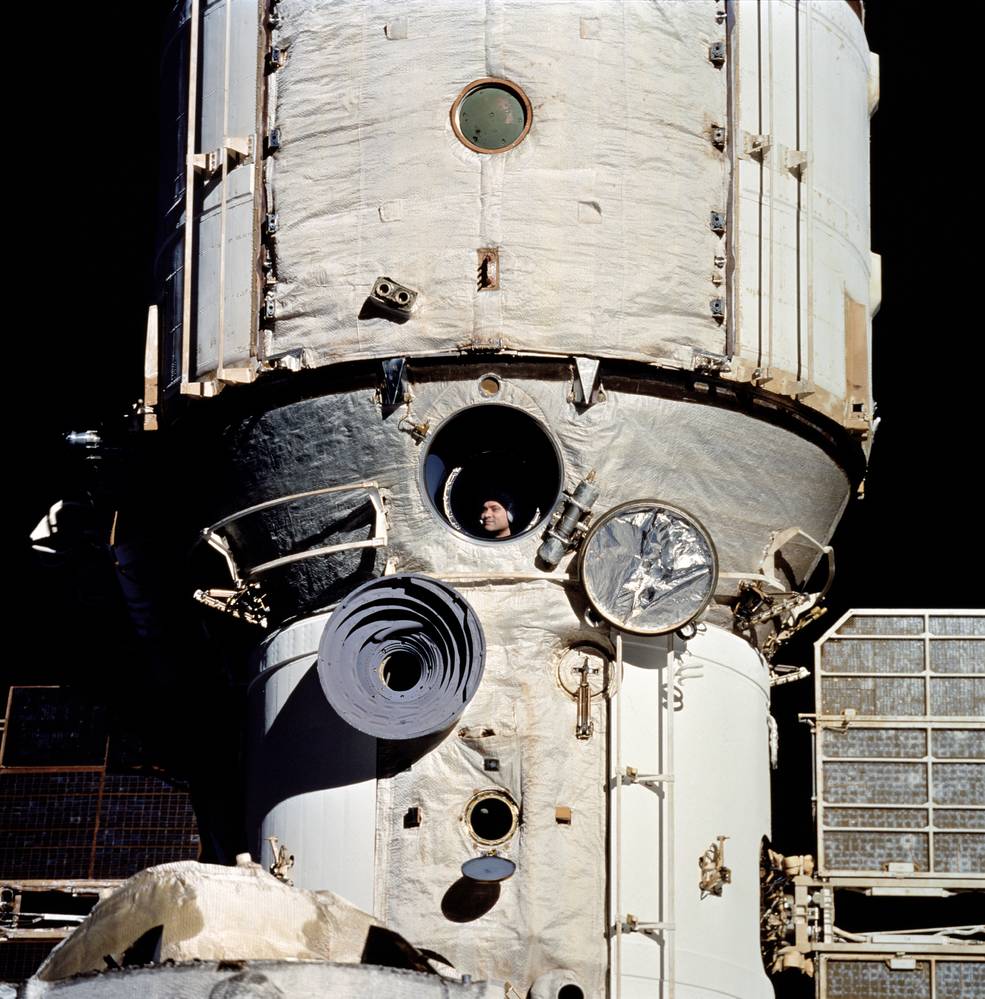
Left: Krikalev eating a meal aboard Discovery during STS-60.
Right: Mir photographed from Discovery during STS-63, with Polyakov
visible in the window at center.
In February 1994, NASA named veteran astronauts Norman E. Thagard and Bonnie J. Dunbar as the prime and backup American crewmembers, respectively, for the planned 90-day stay aboard Mir. Of his selection for the flight Thagard commented, “To be the first American to fly a Russian mission, to actually train with the crew and fly on a Russian craft, had tremendous appeal to me.” Later in the month, Thagard and Dunbar deployed to the Gagarin Cosmonaut Training Center in Star City outside of Moscow to being their year-long training. Flight surgeons Michael R. Barratt and David F. Ward accompanied them to provide medical and other assistance during their training, while fellow astronaut Kenneth D. Cameron, named as the first NASA Director of Operations-Russia, provided support and acted as a liaison to the Russian space program. The Russians later announced that Thagard would be teamed up with Commander Vladimir N. Dezhurov, a first-time space flyer, and veteran Flight Engineer Gennadi M. Strekalov to form the Expedition 18 crew to Mir, with veteran Anatoli Y. Solovyev and space rookie Nikolai M. Budarin forming the backup crew with Dunbar.
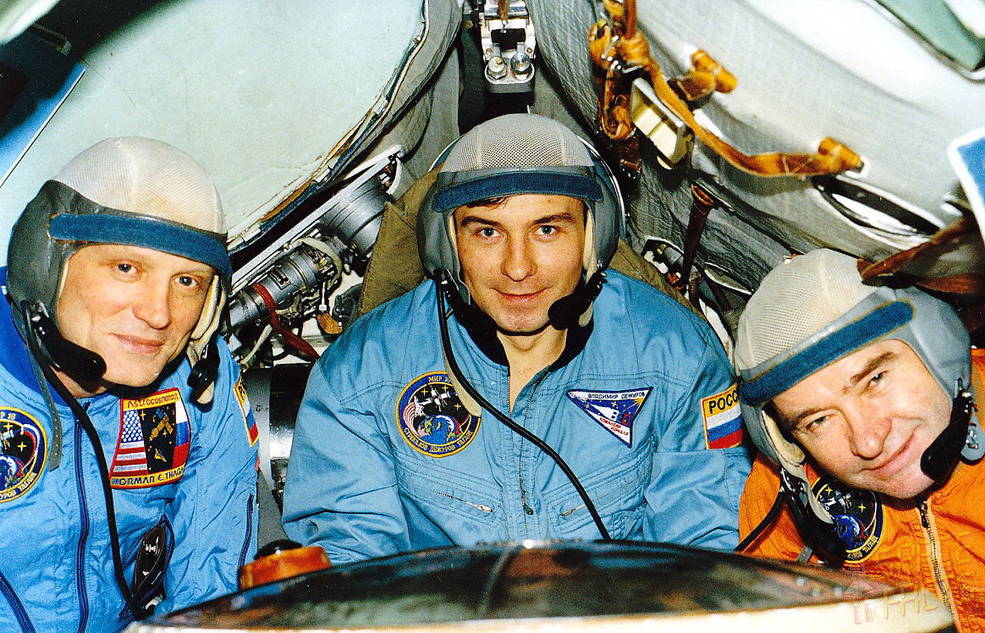
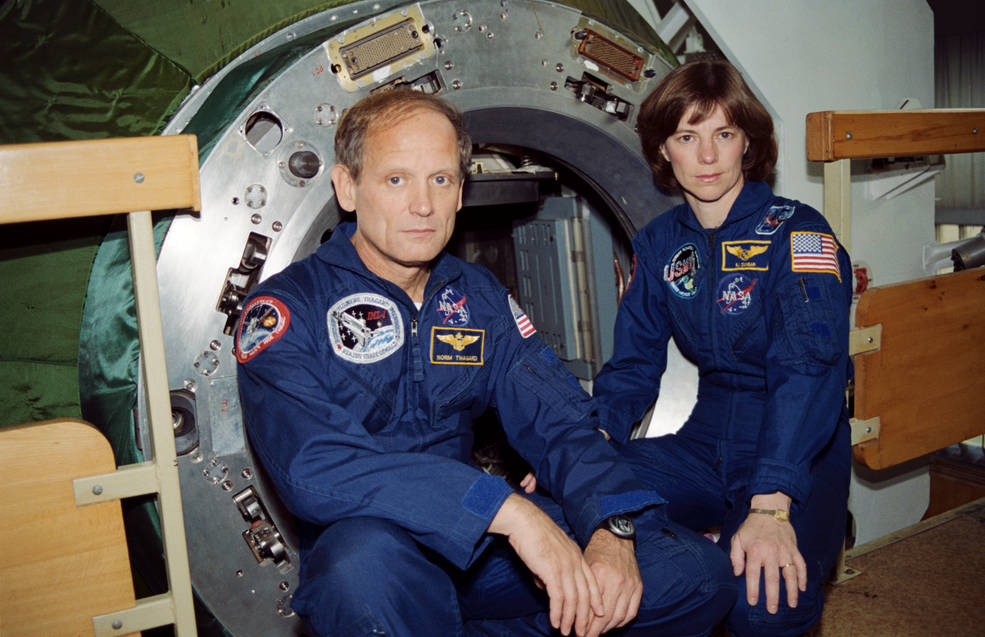
Left: Mir 18 crew (left to right) Thagard, Dezhurov and Strekalov during Soyuz training at Star City.
Right: Thagard (left) and Dunbar in front of the Mir training mockup at Star City.
The majority of training for the Mir 18 mission took place in Russia, with Thagard and Dunbar initially receiving up to four hours per day of intensive Russian language training. As their language proficiency improved, they added training in the Soyuz mockups and simulators to learn that spacecraft’s systems, and eventually they received instruction on the Mir space station’s systems. As part of training for possible emergency landings, Thagard and Dunbar completed winter survival training with Dezhurov. Of the 48-hour outdoor exercise, Dunbar, a veteran on winter camping trips, said, “winter survival … was the most familiar thing” of the training program. The crewmembers completed two shorter training sessions at the Johnson Space Center in Houston. Because joint biomedical investigations featured prominently in their mission’s objectives, all six crewmembers trained in the operation of the experiment hardware and received basic medical training from their flight surgeons. The six astronauts held a joint press conference in June 1994 to describe the training for their mission to reporters, the first such event involving American astronauts and Russian cosmonauts since ASTP 20 years earlier.
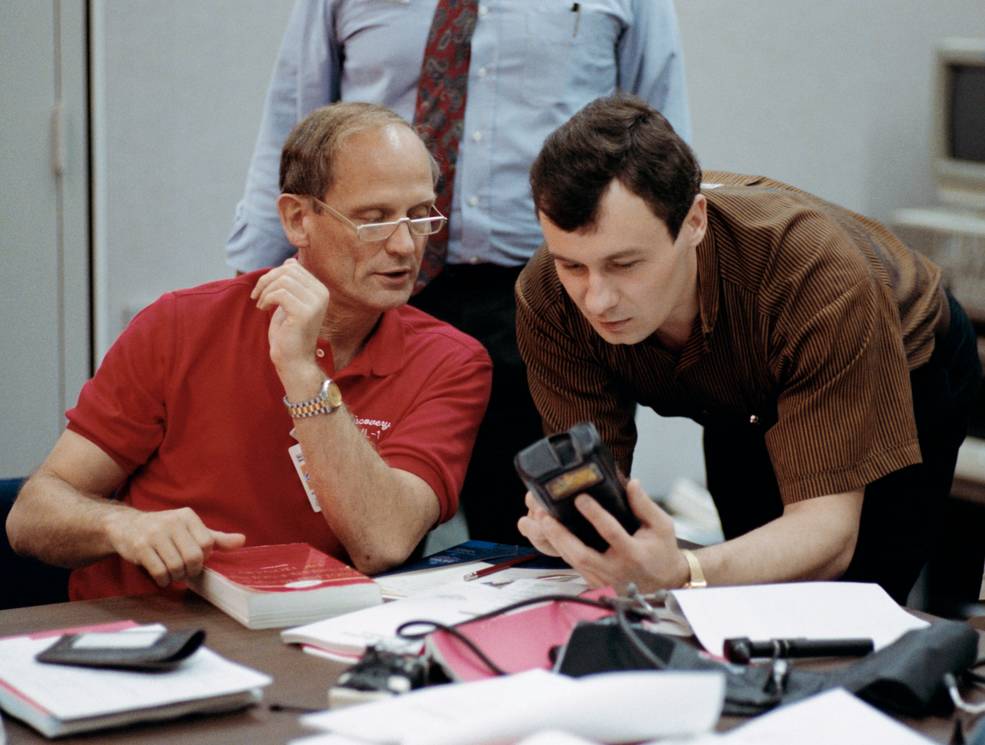
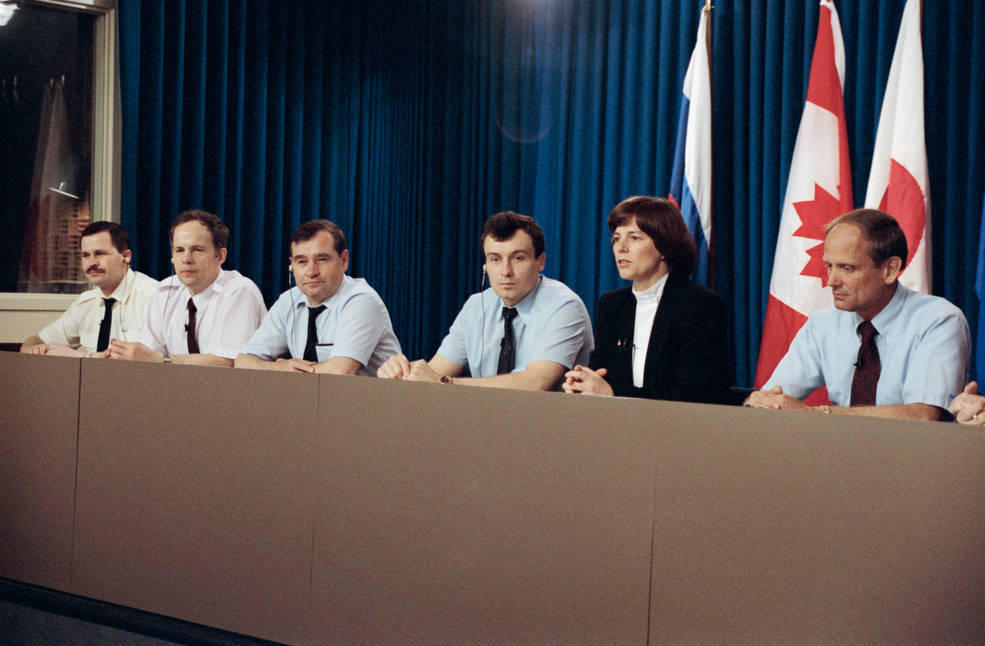
Left: Thagard (left) and Dezhurov training on biomedical experiments at JSC.
Right: Mir 18 prime and backup crews (left to right) Budarin, Solovyev, Strekalov,
Dezhurov, Dunbar and Thagard during a press conference at JSC.
The mission plan called for the Mir 18 crew to return to Earth aboard the Space Shuttle Atlantis during the STS-71 mission. Atlantis would bring Solovyev and Budarin to Mir as the new Expedition 19 crew and Dunbar would be a member of the Shuttle crew. All these crewmembers, the Mir 19 backups Yuri I. Onufriyenko and Aleksandr F. Poleshchuk and the STS-71 crew, completed required Shuttle egress and other training during a session at JSC in October 1994.
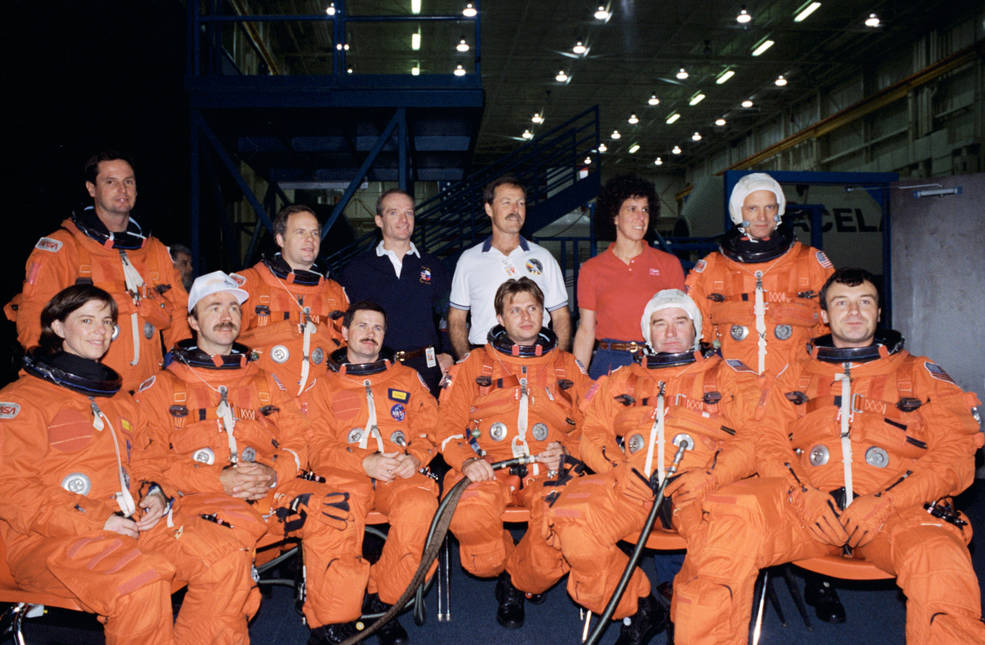
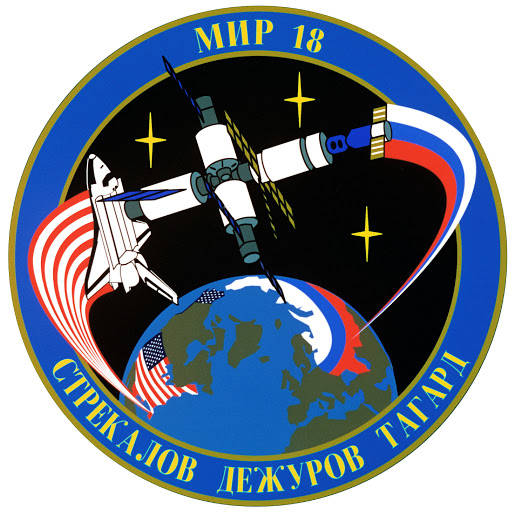
Left: Crews of STS-71, Mir 18, Mir 19 and Mir 19 backups during Shuttle
egress training at JSC. Right: Mir 18 crew patch.
The science program for the Mir 18 and STS-71 missions consisted of 28 joint investigations, with co-principal investigators from the United States and from Russia. Twenty-six of the experiments involved research in four disciplines to study the effects of long-duration spaceflight on human physiology. One fundamental biology experiment involved the study of Japanese quail embryo development and one experiment studied the microgravity environment aboard Mir. The first 91-kilogram (kg) shipment of U.S. hardware including a radiation dosimeter and the microgravity measurement system arrived at Mir in August 1994 via the Progress M24 cargo resupply craft. The Mir 16 crew then aboard the station activated the two experiments shortly thereafter. Progress M26 brought an additional 55 kg of hardware in February 1995 including personal dosimeters and supplies for metabolic and cardiovascular experiments. The Mir 17 crew stowed the hardware aboard the station awaiting Thagard’s arrival.
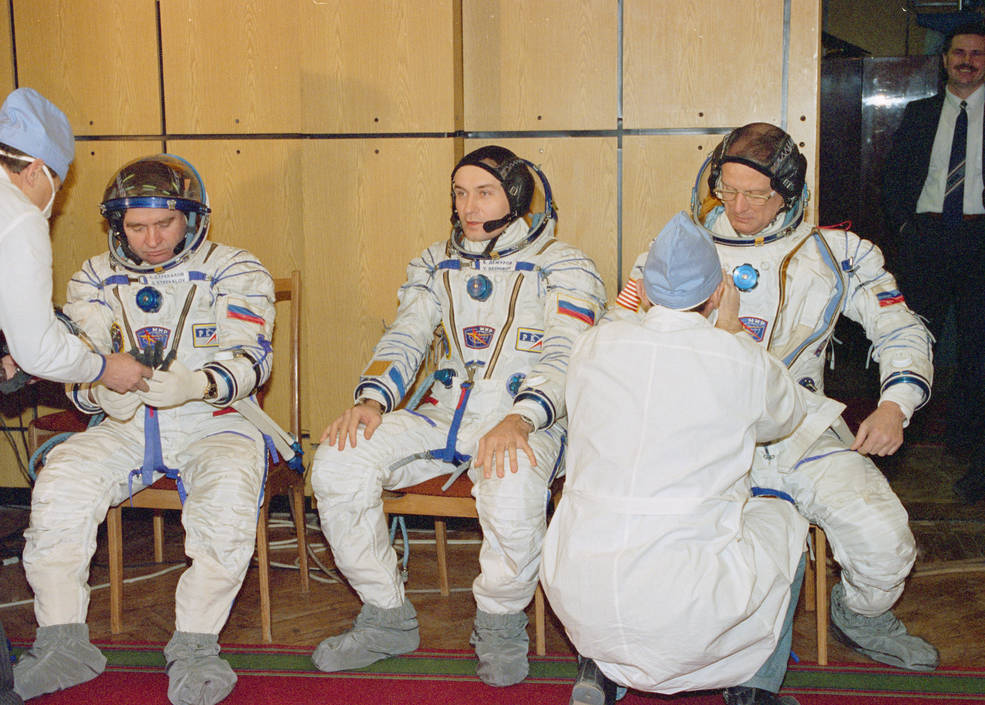
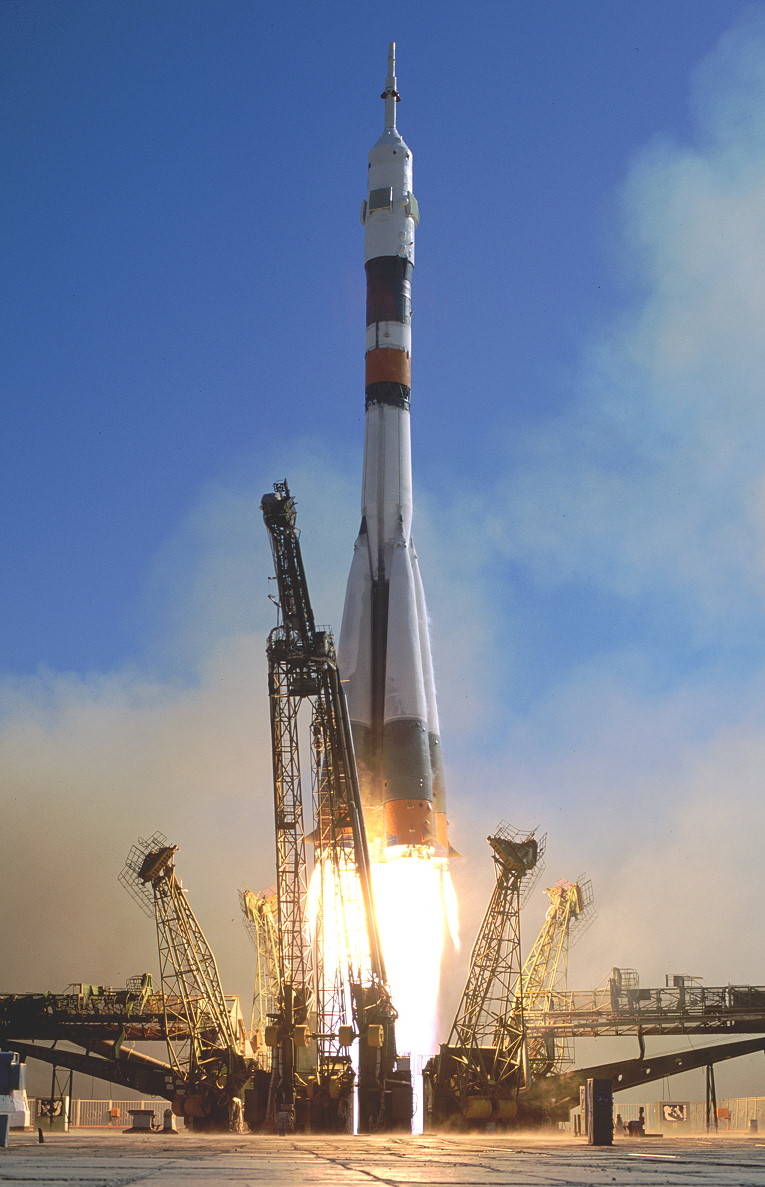
Left: Mir 18 crew (left to right) Strekalov, Dezhurov and Thagard suiting
up for launch. Right: Lift off of the Mir 18 crew aboard Soyuz TM21.
The Mir 18 crew of Dezhurov, Strekalov and Thagard blasted off from the Baikonur Cosmodrome in Kazakhstan aboard Soyuz TM21 on March 14, 1995, marking the first time an American astronaut launched aboard a Russian spacecraft. Once they reached orbit, the total number of people in space grew to a record 13 – the three of them, the Mir 17 crew of Aleksandr S. Viktorenko, Elena V. Kondakova and Valeri V. Polyakov aboard Mir and the seven STS-67 astronauts already in orbit on an unrelated astronomy mission aboard the Space Shuttle Endeavour. Space was getting crowded! Two days after launch, they docked with Mir and Viktorenko, Kondakova and Polyakov greeted them with the traditional Russian welcome of salt and bread. The joint crews received congratulatory messages from American and Russian officials. After a six-day handover, the Expedition 17 crew undocked on March 22 and returned to a landing in Kazakhstan, Viktorenko and Kondakova after 169 days in space and Polyakov after 438 days, still the longest single spaceflight. The Mir 18 crew now had the station to themselves and began their mission in earnest. For Dezhurov and Strekalov that meant conducting maintenance on the space station and preparing for a series of Extra-Vehicular Activities (EVAs) to reconfigure Mir’s docking ports for the arrival of the Spektr module and Space Shuttle Atlantis. Along with Thagard they began some of the mission’s science experiments but much of the hardware was still on the ground due to delays with preparing Spektr for launch. One of the critical hardware items on Spektr was a freezer for storing the collected blood and urine samples, so Thagard temporarily used an onboard freezer provided by the European Space Agency (ESA).
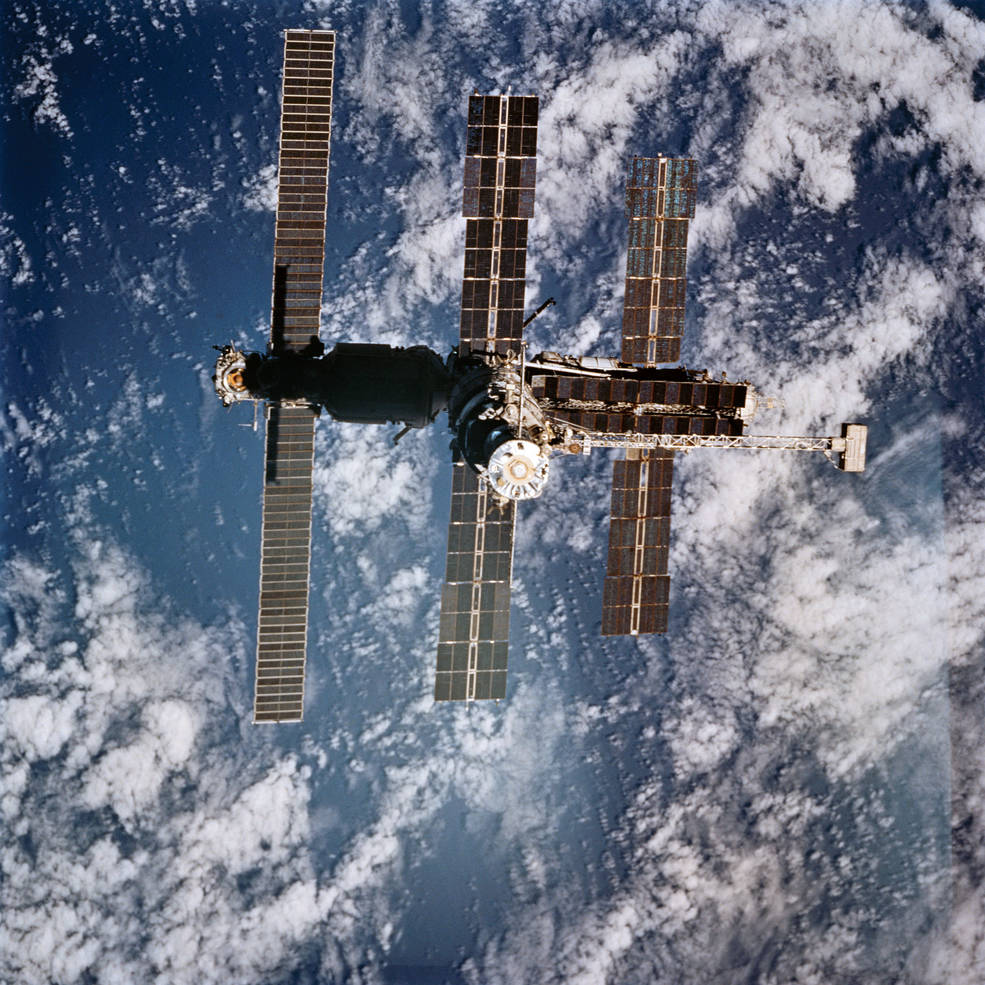
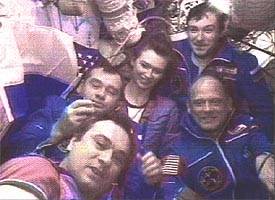
Left: Mir as it would have appeared to the approaching Expedition 18
crew (image taken during STS-63). Right: During the Mir 17 and 18 handover
(clockwise from lower left) Polyakov, Strekalov, Kondakova, Dezhurov and Thagard;
Viktorenko not pictured.
The next cargo resupply vehicle, Progress M27, launched on April 9 and docked with Mir two days later. The cargo included 48 fertilized Japanese quail eggs that the crew placed inside the onboard incubator for a joint experiment on the embryonic development of the birds in weightlessness. The completed experiment was returned to Earth on the Shuttle. Between May 12 and June 10, with Thagard assisting from inside Mir Dezhurov and Strekalov spent nearly 19 hours during five EVAs to reconfigure the station for the arrival of Spektr and the Space Shuttle. They transferred one of the Kristall module’s solar arrays to the Kvant-1 module and retracted the second one to provide clearance for the module’s multiple stepwise relocations from docking port to docking port.
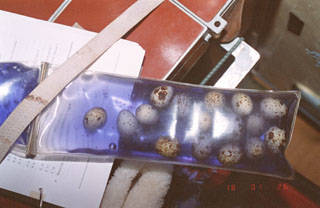
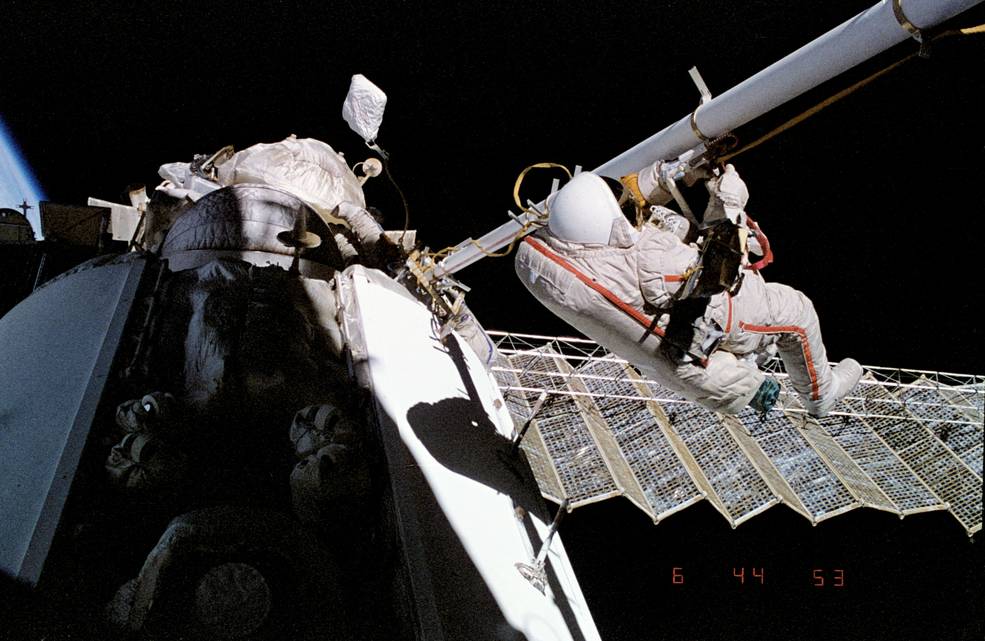
Left: Japanese quail eggs. Right: Dezhurov (in EVA suit with red stripes) and Strekalov
(partly visible behind station structure) during one of the Mir 18 EVAs.
The Spektr research module had been at Baikonur for several months where Russian engineers prepared it for launch. American engineers from JSC soon joined them to perform the final integration and close-out of the 1,553 pounds of NASA science hardware to be used by the Mir 18 and future crews aboard the station. The research hardware included a centrifuge and refrigerator/freezer to process biological samples, a bicycle ergometer for exercise fitness studies and sample collection kits for various experiments.
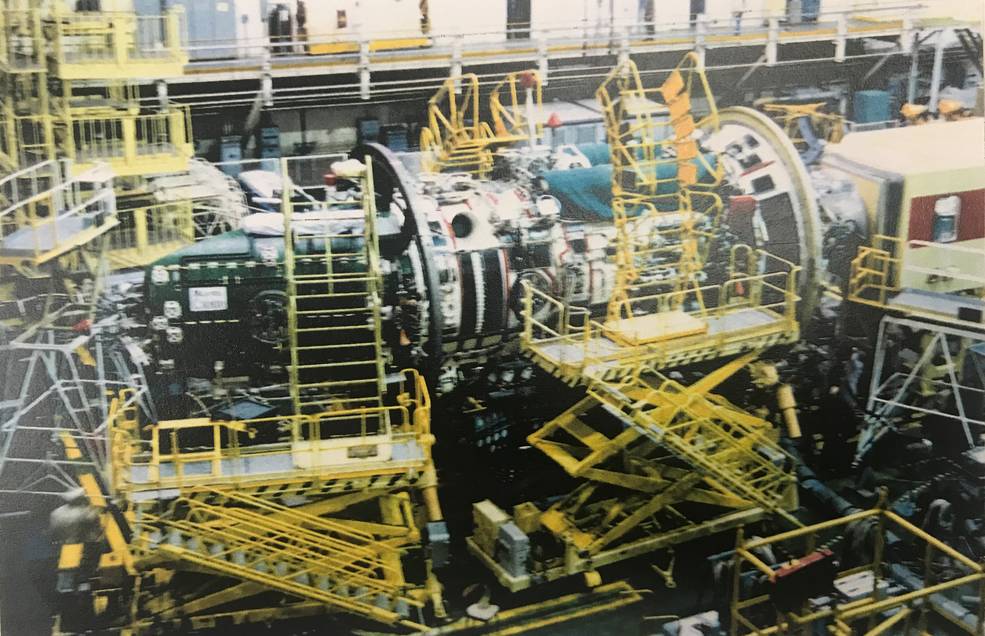
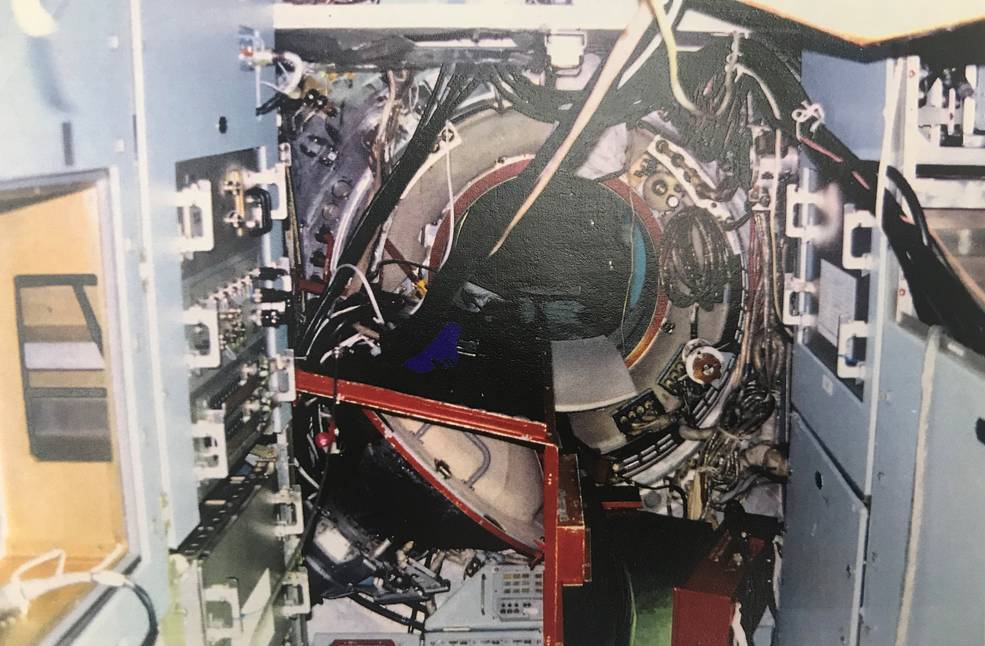
Left: Spektr module undergoing final integration at Baikonur.
Right: Interior of Spektr module during closeout operations at Baikonur.
A powerful Proton rocket lifted off from Baikonur on May 20, 1995, carrying the Spektr module to orbit. On June 1, following a series of rendezvous maneuvers, Spektr docked automatically at Mir’s forward axial port, Thagard calling it “an awesome sight.” The next day, the crew and ground controllers relocated the module to one of the two open lateral ports using its Lyappa robotic arm. On June 6, one of Spektr’s four solar arrays failed to deploy fully, prompting a plan for Dezhurov and Strekalov to perform an EVA to manually unfurl it. Managers dropped the idea when they realized the extra EVA would add too much to the crew’s workload and that the other three arrays generated enough power to meet the station’s needs. The Mir 19 crew of Solovyev and Budarin, after receiving adequate training on the ground, eventually freed the array in July 1995 using tools brought to Mir by STS-71.
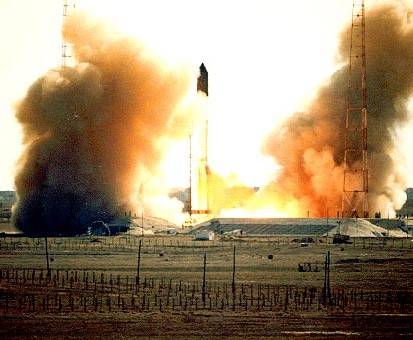
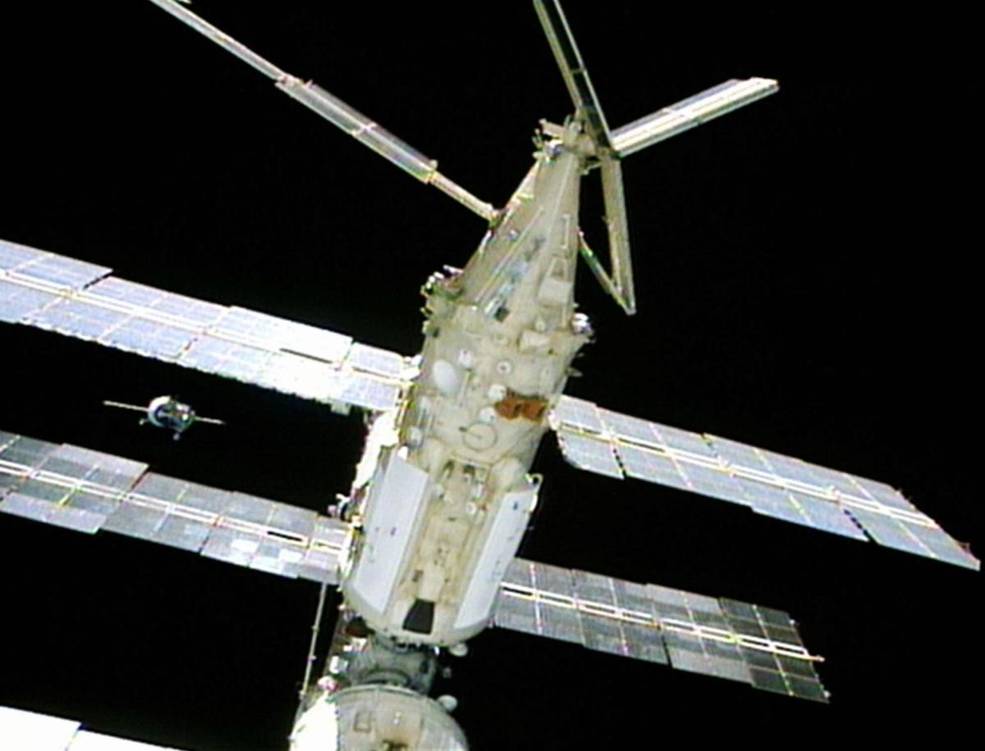
Left: Launch of Spektr module from Baikonur. Right: Spektr module attached to
Mir, showing partially deployed solar array at upper right.
Thagard soon began activating the newly delivered science equipment in Spektr. On June 6, he held a televised news conference, describing to reporters how his mission and research were progressing. The same day he surpassed the Skylab 4 record of 84 days in space, becoming the most traveled American astronaut. “I am happy to have had the opportunity to do this,” Thagard said, adding, “I hope that what this means is that it’s the beginning of an era which Americans will spend long periods of time in space.” On June 12, Thagard transferred the samples from the ESA freezer, nearing the end of its useful life, to the freezer aboard Spektr. All three crewmembers continued the various science experiments while Dezhurov and Strekalov relocated the Kristall module to Mir’s forward axial port, required for the upcoming docking of Atlantis – that module was the only one equipped with the androgynous system to allow docking with the Space Shuttle. The crew began preparations for its return to Earth, packing up samples for transfer to the Shuttle and conducting end-of-mission countermeasures to help with readaptation to Earth’s gravity.
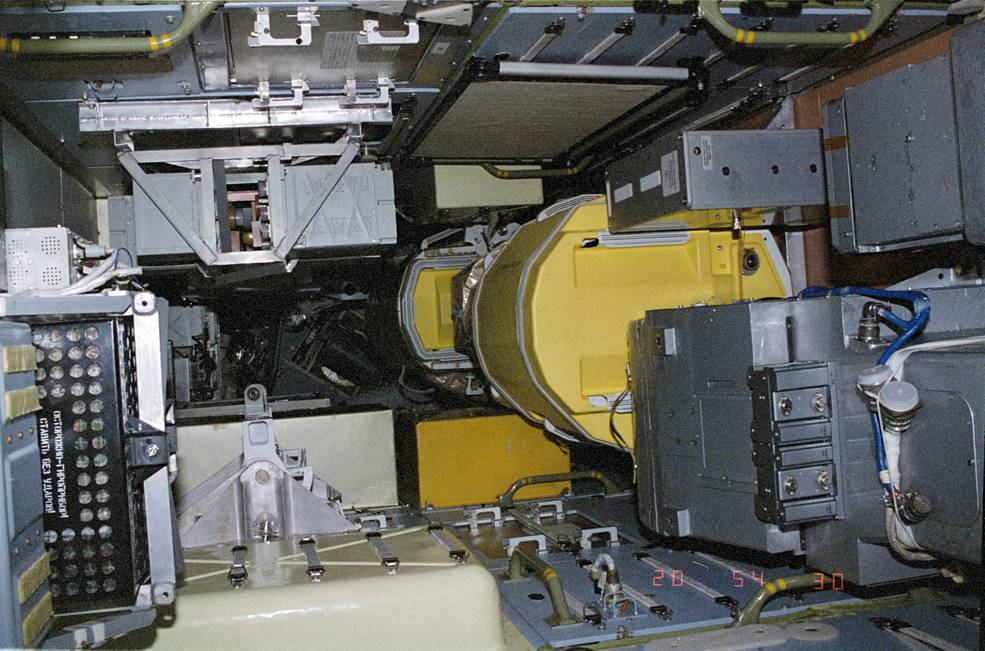
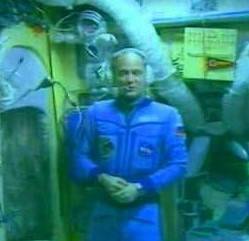
Left: Interior view of Spektr shortly after its arrival at Mir.
Right: Thagard during a press conference.
After four days of weather delays, Space Shuttle Atlantis launched on its historic STS-71 mission on June 27, docking with Mir two days later to form a 220-ton space vehicle, the largest complex up to that time. This first docking between a Space Shuttle and Mir marked only the second time that American and Russian spacecraft docked in space, the first occurred just shy of 20 years earlier during ASTP. Just as the docking system developed for Shuttle-Mir traces its heritage back to that earlier program, so too does the docking system used on ISS.
To be continued…
With special thanks to Charlie Stegemoeller and Gary Kitmacher for archival photographs.














